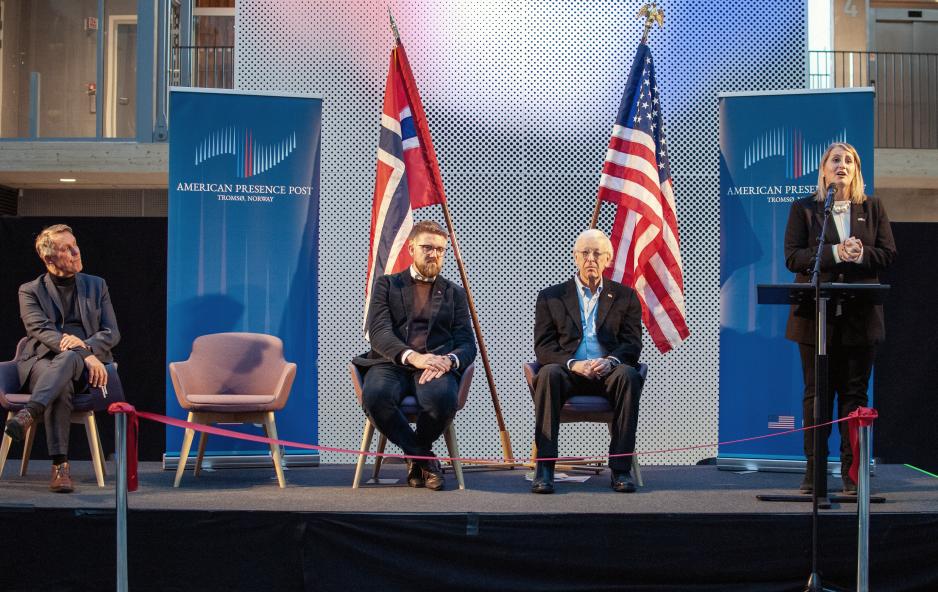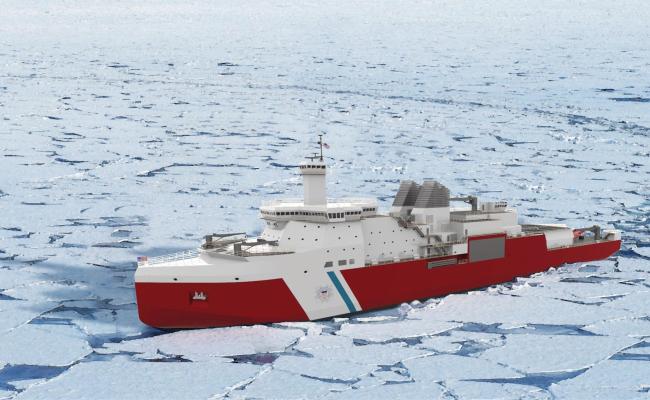US Department of Homeland Security on New Visit in Tromsø: Seeking Arctic Knowledge

Under Secretary Dmitri Kusnezov (to the left) for science and technology in the US Department of Homeland Security, visited UiT – the Arctic University of Norway, on Friday for a knowledge update. Jan-Gunnar Winther, UiT's Pro-Rector for research and development, hosted the meeting. (Photo: Kjetil Rydland/UiT)
Dimitri Kusnezov at the US Department of Homeland Security was recently in Tromsø, Northern Norway, for the second time in less than a year. At UiT, he was introduced to a wide range of Arctic research. Kusnezov says the department wants insight into how the world and the Arctic region appear, as seen from Norway.
Increased knowledge about the Arctic region was the headline as Under Secretary Dimitri Kusnezov visited Tromsø and UiT, the Arctic University of Norway, on Friday, reports the university.
Kusnezov heads the Science and Technology Directorate in the US Department of Homeland Security (DHS, S&T).
With his team, Kusnezov received briefings from UiT researchers on research on various issues in the Arctic, such as climate change and hybrid threats (see overview below).
This is part of the directorate's work in familiarizing itself with research analyses and developing knowledge grounds for policy in the face of significant new times.
Arctic expertise and collaboration
"One goes to the Arctic and sees how things are changing. So, it is a dose of reality – and one of the key strengths of Norway, Norwegian researchers, and the UiT is your understanding of the Arctic. We are here to try to get a sense of what the world looks like from here, with your deep bench of expertise," says Kusnezov.
Jan-Gunnar Winther, UiT's Pro-Rector of Science and Development, hosted the meeting and sees an exciting opportunity for collaboration with the DHS and other US institutions.
"We are always looking for resourceful and highly competent partners. The DHS will soon open a Center of Excellence at the University of Alaska in Anchorage, and there's always the possibility for US researchers and representatives to come to Norway and the European Arctic," Winther points out.
In January, DHS S&T announced the selection of The University of Alaska to lead a consortium av US academic institutions and other partners for a new ADAC-ARCTIC Center of Excellence for Homeland Security in the Arctic. The directorate will provide the center with $46 million over a 10-year period.
The DHS Science and Technology Directorate
– The Directorate was established within the Department of Homeland Security (DHS) in 2003. It serves as the science advisor to the Secretary and the research and development arm for DHS.
– More specifically, the directorate is to provide evidence-based scientific and technological expertise to inform policy-making and directly address a broad spectrum of current and emerging threats.
– Its mission is formulated as follows: "Contribute critical thinking and scientific rigor to deliver effective solutions in homeland security in areas of high impact and value for the nation."
Specific topics
On Friday, Kusnezov and the delegation from S&T received introductions to the following research subjects from UiT researchers:
- The impact of climate change on the Low Arctic Tundra – presented by Rolf Anker Ims, Professor of Ecology and Leader of Climate-ecological Observatory for Arctic Tundra (COAT).
- Climate adaptation in the Arctic (how society can be rigged to endure climate change) – presented by Mina Elisabeth Benjegård, a Researcher in the Climate Impetus project.
- Arctic hybrid security challenges – presented by Gunhild Hoogensen Gjørv, Professor of Security Studies and Geopolitics. She is also the leader of "The Grey Zone" research group and a contributor to the Norwegian Centre for Geopolitics.
- The Future Arctic Ocean, a national interdisciplinary initiative to promote knowledge about climate, environment, policy, business, and resource development in and for the ocean around the North Pole – presented by Vidar Sørum, Head of Department for Arctic and Marine Biology.
- Autonomous ships in Arctic waters – presented by Lokukaluge Prasad Perera, Professor in Maritime Technology.
- Satellite observations for climate modeling and seasonal forecasting of Arctic sea ice – presented by Jack Christopher Landy, Associate Professor in Earth Observation.

Gunhild Hoogensen Gjørv, a Professor of Security Studies and Geopolitics at the Center for Peace Studies, UiT, informs representatives from the DHS S&T about research on Arctic hybrid security challenges. (Photo: Kjetil Rydland/UiT)
Made contact
This was, as mentioned, not the first Tromsø visit for Kusnezov.
He and a delegation traveled to the city in June 2023 to establish connections to Norwegian research institutions and government agencies leading Arctic scientific research, according to the DHS S&T.
UiT was one of these, along with the Norwegian Polar Institute, FRAM – High North Research Centre for Climate and the Environment, the Norwegian University of Science and Technology (NTNU), Kongsberg Satellite Services (KSAT), and the Arctic Council Secretariat.
From the Norwegian ministeries, representatives of the Ministry of Justice and Public Security, the Ministry of Education and Research, and the Ministry of Defense participated.
The event was closed to the press, informs DHS S&T.

The USCGC Healy is one of two active polar icebreakers in the US Coast Guard, which operates under the US Department of Homeland Security. Here, it is docked at Breivika port in Tromsø, Northern Norway, last autumn after a month-long research expedition in the Siberian Arctic. (Photo: Astri Edvardsen)
Coast Guard visit and diplomatic office
In October 2023, a US Coast Guard vessel, the icebreaker USCGC Healy, called in Tromsø after an international research voyage in the Eastern Arctic Ocean. The US DHS is the agency governing the Coast Guard.
Aboard the icebreaker, a scientific roundtable was held for researchers and icebreakers from the US, Norway, and Canada. The topics were best practices in search and rescue, environmental protection, vessel security, and Arctic navigation.
From the Norwegian side, researchers from UiT, the Arctic University of Norway, the Norwegian Polar Institute, the Norwegian Defense Research Establishment, as well as the Commander of the Norwegian Coast Guard vessel KV Svalbard, participated in the meeting.
Later that same month, the US Embassy in Norway re-opened an American Presence Post in Tromsø, citing climate change and geopolitics as reasons.

Nearly 30 years after the US Embassy in Oslo, Norway, closed its diplomatic office in Tromsø, such a presence was revitalized on 27 October last year. Here, Elizabeth M. Allen, US Deputy Secretary of State, speaks during the opening ceremony with the following representatives on stage (from the left): Tromsø Mayor Gunnar Wilhelmsen (Labor); Eivind Vad Petersson (Labor), State Secretary in the Norwegian MFA – and Marc Nathanson, the then US ambassador to Norway. (Photo: the Norwegian Ministry of Foreign Affairs)






